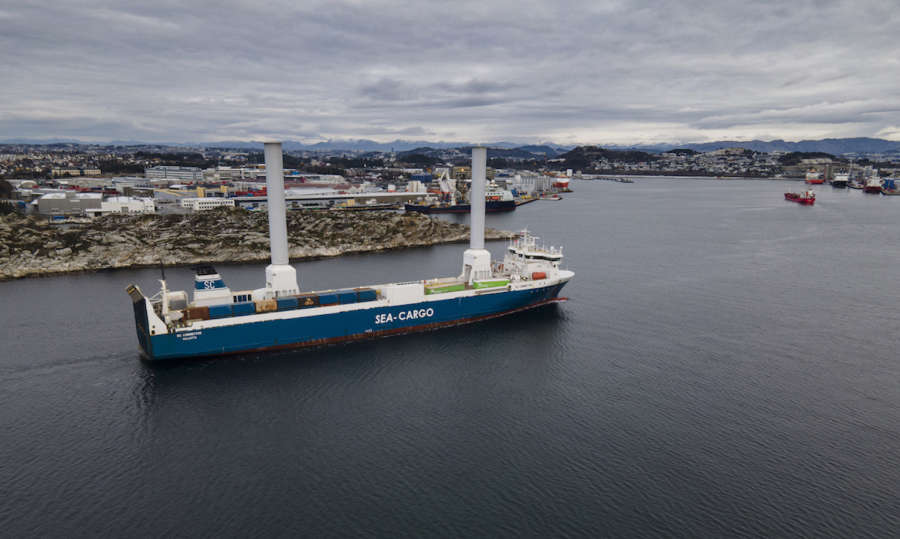As shipping progresses its journey to decarbonise ahead of the IMO’s ambitious 2030 and 2050 GHG emissions reduction targets, a perfect storm of additional regulatory and commercial drivers require the sector to invest in new initiatives, like the use of Rotor Sails, sooner rather than later.
The regulatory push
There is a danger in waiting to see how the availability and uptake in low carbon fuels ahead of the IMO’s 2030 and 2050 deadlines will develop and there will inevitably be a significant high carbon intensity energy gap to fill through other means. Under the EEXI regulation, at the first annual survey after entry into force in 2023, ships are required to demonstrate compliance with EEXI standards. Values for each ship involve a calculation of energy efficiency and CO2 emissions. The carbon intensity indicator (CII) determines the annual reduction factor needed to ensure continuous improvement of the ship’s operational carbon intensity within a specific rating level from A to E which would be recorded in the ship’s Ship Energy Efficiency Management Plan (SEEMP). According to IMO, under CII, a ship rated D for three consecutive years, or E, would have to submit a corrective action plan, to show how the required index (C or above) would be achieved.
DNV GL estimates that up to 80% of the global trading fleet will have to make technical upgrades to meet the incoming minimum energy efficiency standards within EEXI and CII. They also stated that reducing installed power would be the most effective method to improve a ship’s EEXI rating.
When looking at meeting compliance and exploring technologies like Norsepower’s Rotor Sails it is important to remember one factor – every ton of fuel makes over three tons of CO2. The installation of a Rotor Sail achieving mean fuel, fuel cost, and emissions savings of for example 10% would always also improve a vessel’s EEXI rating by around 5-15%, depending on the actual case. This EEXI improvement is a direct consequence of massive decreases in fuel consumption and costs – making investments in wind propulsion technologies sound even when looked at on a simple financial basis.
Commercial drivers
In addition to cost savings, sustainable investing is also becoming a key driver in financing fleets that are fit for the future. The Global Maritime Forum’s Poseidon Principles and the Sea Cargo Charter, as well as the newly formed The Mission Possible Partnership (MPP), represent a much wider recognition of environmental, social and governance (ESG) measures at the core of future business from investors and a growing number of customers. Even though almost a third of shipowners say that ESG criteria barely influences their investment decisions, according to a report by Watson Farley Williams, nearly 90% of financiers regard ESG as having some or even crucial importance. Consequently, investments are increasingly being based on vessels’ efficiency and emissions performance as well as age. According to the Poseidon Principles Association, emissions are just as much about operations as they are ship design. They advocate that existing fleets are better retrofitted than building new ships with old technology and that operational data can be used to justify lending to an older ship.
Future proofing assets
Investing in clean technology such as Rotor Sails has become sustainable shipping’s no brainer to prepare vessels for these changes. Not only does a retrofit or newbuild installation of the Rotor Sail support compliance with the new EEXI and CII rules, as a direct consequence it also significantly decreases fuel consumption and costs. Investment in such clean technology that reduces fuel consumption also offers an opportunity to future proof vessels against inevitable fuel price increases as new fuels like ammonia and hydrogen enter the market. For example, a 10% fuel saving from a Rotor Sail can mean the difference between operating profitably or not as new fuels enter the market and a cost for carbon emissions is implemented.
Environmental efficiency is also likely to become an increasingly important factor in determining ships’ resale value, therefore, investing in clean technologies such as Rotor Sails will become beneficial for protecting the asset value of ships.
We anticipate that the relevance of clean technology options will only intensify as compliance standards tighten, with up to 80% of the global trading fleet being estimated to require investment to meet minimum EEXI and CII standards. This will naturally place enormous pressure on ship owners and will lead to an increase in decommissioning and shipowners facing bankruptcy.
To prevent widespread market consolidation and to futureproof a high performing fleet, wind propulsion, really does have it all – it is commercially available, reduces the high carbon intensity gap until new fuels arrive, future proofs assets, saves money now; and has the potential to save more in the future.


